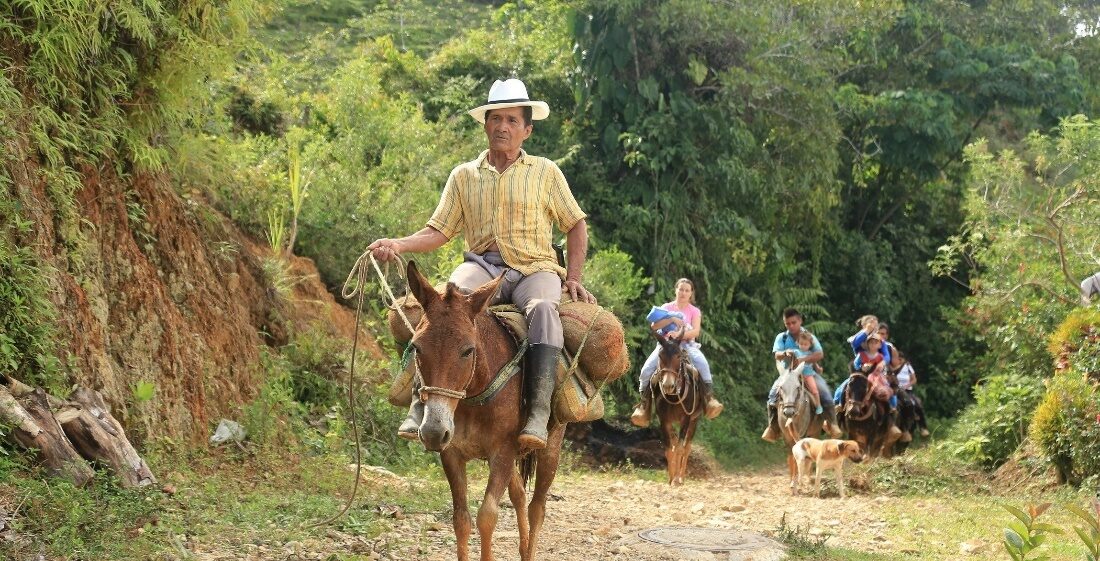Since the signing of the Peace Agreement on November 24, 2016, the normative development of the Comprehensive Rural Reform – CRR has been limited to the creation of the Development Programs with Territorial Approach – PDETs, the creation of the Land Fund, the adoption of the procedure for the Formalization of Property, the initiation of the Multipurpose Cadastre, and the adoption of 6 National Plans for the Comprehensive Rural Reform – PNCRR.
The Kroc Institute’s monitoring indicators show that in rural areas 4% of commitments have been completed and another 10% are just beginning. For the remaining 86%, little or nothing has been done, the handing over of hectares of land free of charge has not yet taken off, the agrarian jurisdiction has not been regulated and only 6 of the 16 CRR National Plans have been implemented, despite the fact that the Agreement provided for its approval during the first year of implementation.
There has been no progress in regulatory matters since May 31, 2019, and despite the fact that the state of regulatory implementation of the Agreement is incomplete, Duque’s government has not filed any bill to develop the Agreement in the legislature that began last July 20.
The current state of implementation may be understood from two variables: i) the delay in the normative development of the points of the Agreement and ii) the implementation of a government peace policy that ignores the spirit of the Agreement and simulates its compliance.
For example, on the point related to access to and use of land, the Agreement orders the creation of a Land Fund, of a permanent nature, which in its first 12 years of creation will have 3 million hectares to be allocated free of charge to peasants without land or with insufficient land. At the same time, it provides for the formalization of 7 million hectares of small and medium property.
The Land Fund was created in the established time and, according to figures from the National Land Agency (ANT), 1,000,404 hectares have been entered, which represents an advance of 33% against the goal of 3 million. However, on this point two issues must be borne in mind:
- After the first four years of implementation of the Agreement, the first hectare of land given free of charge to landless peasants has still not been registered, which implies a delay in meeting the goals of the Agreement, which requires the material and legal handing over of 1 million hectares under the current government (2018-2022), or about 250,000 hectares per year for its fulfillment.
- It is not clear the origin of the hectares that have fed the Land Fund so far. According to the Office of the Inspector General of Colombia – PGN, the majority of the hectares that have entered the Fund correspond to the transfer of land registered before 2017 in the National Agrarian1 Fund and, from the area entered, it is not possible to determine whether it has actually entered the Fund legally and materially. It is likely that the majority of these rural properties are immobilized for adjudication in property disputes and therefore do not meet the conditions for material handing-over to peasants and ethnic communities. In other cases, these are unduly occupied vacant lots2.
If the lands that have entered the Land Fund cannot be handed over to landless peasants because most of them are occupied, the formalization of rights proceeds on these properties and not the adjudication, and therefore they should be understood as progress in the fulfillment of the commitment to formalize ownership, not the handing over of land. The presentation of figures corresponding to the formalization of property as progress in the commitment to hand over land is a government practice that seeks to simulate compliance with the Agreement.
The 33% progress presented by the government (compared to the goal of 3 million hectares) is also questioned by control bodies such as the Office of the Inspector General of Colombia – PGN. This agency claims that in reality 0.3% of the goal of land allocation has been met, if the 8,230 hectares handed over via land access subsidy are taken into account3. However, it should be noted that the Agreement establishes that the 3 million hectares to be awarded, which includes the Land Fund, are to be distributed free of charge4; therefore, these measures of access to land via subsidies may not be understood as progress in the compliance of the Land Fund.
In formalization, there are various figures, but the one given by the National Land Agency – ANT serves as a reference: since the beginning of the implementation of the final Agreement, until February 2020, 10,554 hectares have been formalized (of the goal of 7 million hectares), which represents approximately 3,332.8 hectares per year. Taking into account the goal of the final Agreement, and according to the figures of the ANT, the State is formalizing 0.47% of what it ought to be doing per year5.
Within the framework of the land formalization policy that Duque’s government is implementing, the formalization of the Peasant Reserve Zones (ZRCs) has not been activated. The ZRCs were born with Law 160 of 1964, and between 1995 and 2000, 7 of them were formalized. Since then, and despite the fact that the Agreement has prioritized the ZRCs in the processes of formalization of property, the 19 applications for the constitution of ZRCs have not been processed, nor has progress been made in the planning of another 15.
With regard to the progressive access to property by peasant, indigenous and black communities, Afro-descendants, palenque and raizal communities (NAPR) and the Roma people: 3,875 hectares had been allocated and 52% of these were received by indigenous communities, 35% by peasant communities and 13% by black communities. It should be noted that none of the territories titled to ethnic communities are among those prioritized by the Special High Level Committee on Ethnic Peoples for the Monitoring of Implementation of the Final Agreement6.
The Policy for the Implementation of the Multipurpose Cadastre that is being implemented highlights that, among the 1,122 municipalities in Colombia, 28% do not have cadastral training and 69.3% have outdated information; figures that allow us to measure the importance of advancing in the implementation of the cadastre. The policy that the government has been carrying out is developed from pilot projects in some prioritized municipalities in order to subsequently expand the project to reach 100% of the national territory with a formed or updated cadastre by 2025. The government has contracted a credit of US$150 million with the Inter-American Development Bank and the World Bank.
There is concern about security conditions in some municipalities prioritized for the cadastre: of the 22 municipalities incorporated in the 2020 work plan, only 3 do not have a presence or suspicion of anti-personnel mines, 4 have been intervened and released from suspicion of anti-personnel mines and in 9 of them, although they have been allocated, operations are suspended due to security conditions7.
The cadastral update in municipalities prioritized for the Development Programs with Territorial Approach – PDETs is of particular interest, which presents not very significant results: the goal for the four-year period is the 170 PDETs municipalities, which represent a little more than 39 million hectares. In 2019, the update of two municipalities was achieved: La Jagua de Ibirico, in Cesar, and Ovejas, in Sucre, (10.31% of the total area of the PDETs municipalities). In 2020, no progress has been made in the process and it is reported that inputs are being prepared to begin updating in 10 municipalities with an area of 999,718 hectares (3% of the goal) in the second half of the year8.
Development Programs with Territorial Approach – PDETs are conceived by the Agreement as instruments of participatory territorial planning to implement the components of CRR as a matter of priority. This is the sub-point of CRR that presents the greatest progress in its implementation: the Action Plans for Regional Transformation – PATRs have been designed in each of the 16 PDETs sub-regions. However, there are no documents that allow for the identification of objectives, priorities, goals, programs and projects for each of them. In the same manner, several social organizations have denounced serious limitations to community participation in the design of the PATRs.
The Agreement conceives the PDETs as a gear of the CRR, with all the scaffolding of plans and its contribution to strengthen the peasant, family, community and ethnic economies, prioritizing community participation in its design and implementation. However, the Duque’s policy “Peace with Legality” intends to ignore the spaces of community participation created in the Agreement, and to articulate the PDETs with military strategies of territorial control. This is evidenced by the implementation of the so-called Strategic Zones for Comprehensive Intervention – ZEII or “Future Zones”.
With the Future Zones, the objective is to promote a centralized security policy that ignores the territorial approach. It is a new logic of state intervention characterized by militarism, which seeks to strengthen the presence of the Army in regions where armed confrontation, illicit crops and weak institutional presence persist. The government defined 5 Future Zones9, which correspond to 2.4% of the national territory and overlap with the PDETs zones. It should be recalled that the 50 US military personnel who arrived in Colombia on June 1 focused their action on Tumaco, Catatumbo and Chiribiquete, three of the five Duque’ s Future Zones.
Civil society organizations presented a guardianship to prevent the implementation of the Future Zones in the PDETs, this public action was denied by the Council of State, a corporation that stated that the implementation of the Future Zones should be in harmony with the purposes established by the Agreement for the PDETs. Although the articulation between these territorial ordering figures is a good purpose, the execution phase makes it possible for national security objectives to displace those of incorporation and strengthening of local economies and communities.
With regard to financing, the National Development Plan provides very limited resources for the municipal plans and the 16 regional plans of the PDETs, which require 90 billion Colombian pesos over 12 years. Moreover, at the rate assigned to the agricultural sector in the budgets of Duque’s administration, the PDETs and the PATRs will only be able to get a boost in the zones that coincide with the Future Zones and where the interests of large investors willing to implement “Public Works Tax Deduction” to bet on mega-mining or agro-industry are indicated10.
1 The National Agrarian Fund, created in 1961, is the group of assets intended to make the social investment of the Colombian State in the area of Agrarian Reform, and includes rural properties that can be adjudicated in accordance with the requirements established by law.
2 Office of the Inspector General of Colombia. (September 2020) Second report to Congress on the state of progress of the implementation of the Peace Agreement.
3 Op. Cit. Pg. 49.
4 Final Agreement to End the Armed Conflict and Build a Stable and Lasting Peace , page 14.
5 Senators and Representatives – Multiparty Report (2020) What is Peace About? Implementation figures 03 report.
6 Gonzalez Posso, Camilo. Institute of Studies for Development and Peace –Indepaz (2020) Anti-agrarian Reform suffocates Comprehensive Rural Reform.
7 Office of the Inspector General of Colombia. (September 2020) Second report to Congress on the state of progress of the implementation of the Peace Agreement.
8Technical Secretariat of the International Verification Component CINEP/PPP-CERAC (September 2020) Seventh report on the verification of the implementation of the Final Peace Agreement in Colombia.
9 They are located in: i) Nariño Pacific; ii) Catatumbo; iii) Lower Cauca and southern Córdoba; iv) Arauca and v) Chiribiquete and surrounding National Natural Parks.
10 Gonzalez Posso, Camilo. Institute of Studies for Development and Peace –Indepaz (2020) Anti-agrarian Reform suffocates Comprehensive Rural Reform.

